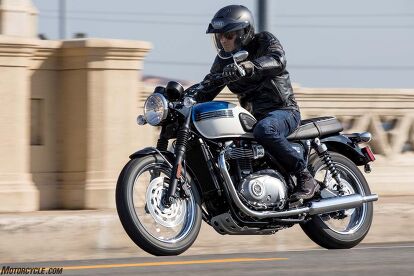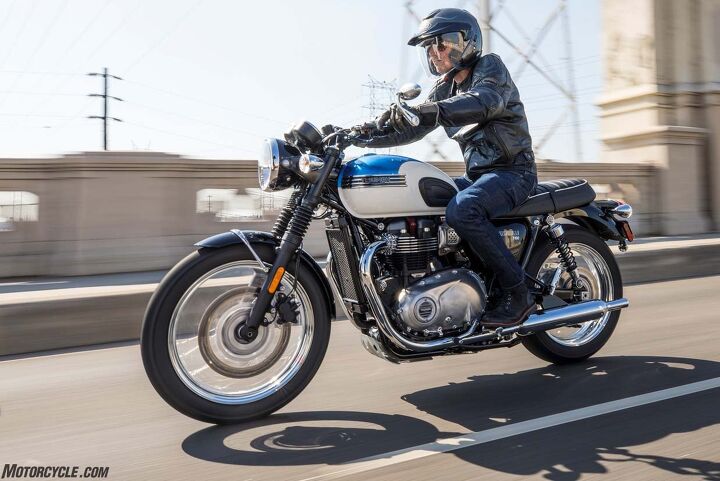2017 Triumph Bonneville T100 First Ride Review
The latest Bonnie is a well-mannered middle child
Triumph’s new Bonneville platform has already made a significant impact on the moto market in less than a year. Spearheaded by the 900cc Street Twin and followed closely by the 1200cc T120 Bonneville and Thruxton models, the retro-modern roadsters are selling as quickly as Triumph can build them, with strong sales forcing the company to add an extra shift at its factory to meet demand.
2017 Triumph Bonneville T100
| Engine | 17.75/20 |
| Suspension/Handling | 13.0/15 |
| Transmission/Clutch | 9.0/10 |
| Brakes | 7.5/10 |
| Instruments/Controls | 4.25/5 |
| Ergonomics/Comfort | 9.25/10 |
| Appearance/Quality | 9.0/10 |
| Desirability | 8.5/10 |
| Value | 9.0/10 |
| Overall Score | 87.25/100 |
2016 Triumph Street Twin First Ride Review
2016 Triumph Bonneville T120 First Ride Review
2016 Triumph Bonneville Thruxton R First Ride Review
“This new platform was the biggest project for the Hinckley-era Triumph,” Miles Perkins, Triumph’s Head of Brand, told us this week, adding it required five years of development work. We recognized Triumph’s achievement by giving the Bonneville platform our 2016 Motorcycle of the Year award. Perkins says demand for the modern classics is a massive 68% higher than the company expected.
The production challenges won’t get any easier after the introduction of this new T100 version of the Bonneville, which marries the engine of the Street Twin with the T120’s chassis and appearance. Other than the smaller motor, the key distinctions for the T100 are the move to a single-disc front brake, the absence of a centerstand and passenger grab-rail, and the loss of ride modes. Oh, and no contrasting seat piping (accessory seat shown here) and no standard heated handgrips as on the T120.
So, if we boiled down the review of the T100, it’s basically a Bonneville lacking a couple of features with a Street Twin motor slipped inside, and the riding impression backs that up.
A rider is greeted with an exceedingly neutral riding position, with a manageable 31.1-inch seat height and a very modest reach to the handlebars. The torque-assist clutch is almost laughably light in its pull yet easy to modulate, and the 5-speed gearbox is precise. Throttle response is free of any glitches, making the lack of ride modes inconsequential.
Despite having 300 fewer cubic centimeters than the T120, there is plenty of squirt on tap from the T100’s 900cc eight-valve, single-overhead-cam parallel-Twin engine. Triumph was pessimistic when it claimed just 54 hp at its crankshaft, as we measured 52.6 hp at the Street Twin’s rear tire. Peak torque should be equivalent to the 57.8 lb-ft of the Street’s, but it’s the vast spread of twist that is far more impressive than the maximum value. The sound emanating from the peashooter mufflers is pleasingly deep and boisterous, even if its 270-degree crank summons a different tune than the 360-degree cranks of old.
Triumph Street Twin vs. Harley-Davidson Street 750 vs. Moto Guzzi V7 II Stone
Although lacking a few of the T120’s features, the T100 is far from spartan. It boasts standard traction control and ABS to lend a hand if yours become inadequate, and it one-ups the Street Twin’s single-pod gauges for a pair of pods from the T120, which includes a gear-position indicator, fuel gauge, clock and trip computer, as well as a tachometer. A USB socket under the seat is ready to charge portable electronic devices. Heated grips and cruise control are available options, as are the adjustable levers and bar-end mirror seen on our test bike.
The T100’s handling is very similar to the T120’s, of course, but it’s not quite the same. The absence of a brake rotor and caliper from its front wheel allows the junior Bonnie to initiate turns with less effort. The difference isn’t huge, but it is noticeable. Braking power isn’t up to the same level as the big Bonnie, but I was nevertheless pleased with the feel through the lever and ultimate speed retardation considering how the bike’s intended purposes.
The brake (and centerstand and grab-rail) missing from the T120 adds up to 24 fewer pounds for the T100, according to the dry weights claimed by Triumph. Subtracting two dozen pounds from the 542 lbs we measured with a T120 should result in a full-up curb weight of 518 lbs. Incidentally, the Street Twin scaled in at 478 lbs with its 3.2-gallon tank filled.
Also splitting the difference is the T100’s MSRP, which starts at $10,300. That’s $1,200 cheaper than a nearly identical T120, but it’s a $1,600 premium over the more contemporary-styled Street Twin. Triumph builds the Bonneville lineup in Thailand to reduce build costs, but there are probably more than a few Britons who can remember much shoddier Triumphs built in England.
2017 Triumph Bonneville T100
+ Highs
- Classic style from iconic brand
- Attention to detail
- Versatility
– Sighs
- Slightly porky
- Not made in England
- Street Twin $1.6k cheaper
The T100 actually has three price points, starting with the Jet Black version and stopping at the two-tone versions (blue or orange) listed at $10,800. “Sophisticated urban style” is offered via the T100 Black model, which features dark engine covers, exhaust, wheel rims, mirrors and turn signals. Your choice of Jet Black paint or Matt Black for $10,550.
In the amount-of-motorcycle-for-the-dollar category, the Street Twin is a better value. But in the I’ve-always-wanted-a-Bonneville category, the value of the T100 can’t be beat.

Helmet: Shoei J-Cruise
Jacket: Spidi Ring
Gloves: Joe Rocket
Jeans: Dainese Bonneville
2017 Triumph Bonneville T100 Specification | ||
|---|---|---|
| Engine Type | Liquid cooled, 8 valve, SOHC, 270° crank angle parallel twin | |
| Engine Displacement | 900cc | |
| Bore/Stroke | 84.6mm x 80mm | |
| Compression Ratio | 10.55:1 | |
| Maximum Power (Claimed) | 54 hp at 5900 rpm | |
| Maximum Torque (Claimed) | 59 lb-ft. @ 3230 rpm | |
| Fuel system | Multipoint sequential electronic fuel injection | |
| Exhaust | Chromed 2 into 2 exhaust system with twin chrome silencers (Black 2 into 2 exhaust system with twin black silencers for Bonnevill T100 Black) | |
| Final drive | X ring chain | |
| Clutch | Torque assist. Wet, multi-plate. Cable operated. | |
| Gearbox | 5-speed | |
| Frame | Tubular steel twin cradle | |
| Swingarm | Twin-sided, tubular steel | |
| Front Wheels | Wire 32-spoke – Steel Rims. 18 x 2.75in | |
| Rear Wheels | Wire 32-spoke – Steel Rims. 17 x 4.25in | |
| Front Tires | 100/90-18 | |
| Rear Tires | 150/70-R17 | |
| Front Suspension | KYB 41 mm forks, 120 mm travel | |
| Rear Suspension | KYB twin shocks with adjustable preload, 120 mm rear wheel travel | |
| Brakes Front | Single 310 mm floating disc, Nissin 2-piston floating caliper, ABS | |
| Brakes Rear | Single 255 mm disc, Nissin 2-piston floating caliper, ABS | |
| Front Wheels | Wire 32-spoke – Steel Rims. 18 x 2.75in | |
| Rear Wheels | Wire 32-spoke – Steel Rims. 17 x 4.25in | |
| Front Tires | 100/90-18 | |
| Rear Tires | 150/70-R17 | |
| Width at Handlebars | 28.1in (715mm) | |
| Height Without Mirror | 43.3in (1100mm) | |
| Seat Height | 31.1in (790mm) | |
| Wheelbase | 57.1in (1450mm) | |
| Rake | 25.5º | |
| Trail | 4.1in | |
| Dry Weight | 470lb | |
| Tank Capacity | 3.8gal | |
| Tank Capacity | 4.6 gallons | |
| Fuel Economy (Claimed) | 61.4 mpg | |
| Instrument Display and Functions | LCD multi-functional instrument pack with analogue speedometer, analogue tachometer, odometer, gear position indicator, fuel gauge, range to empty indication, service indicator, clock, 2x trip, average & current fuel consumption display, traction control status display, throttle mode status display, heated grip status (accessory) and cruise control ready – controlled by a handlebar mounted scroll button (accessory). | |
More by Kevin Duke




































































Comments
Join the conversation
The bike looks good can't be much to ride by the lack of smile on the rider, or is he making like a 10 year old and frowning thinking we'll think more of him?
A Triumph built in Thailand.....Something just seems wrong about that.